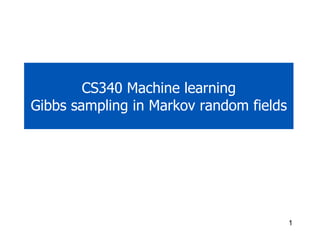
Image denoising
- 1. CS340 Machine learning Gibbs sampling in Markov random fields 1
- 2. Image denoising x y ˆ x = E[x|y, θ] 2
- 3. Ising model • 2D Grid on {-1,+1} variables • Neighboring variables are correlated 1 p(x|θ) = ψij (xi , xj ) Z(θ) <ij> 3
- 4. Ising model eW e−W ψij (xi , xj ) = e−W eW W > 0: ferro magnet W < 0: anti ferro magnet (frustrated system) 1 p(x|θ) = exp[−βH(x|θ)] Z(θ) H(x) = −xT Wx = − Wij xi xj <ij> β=1/T = inverse temperature 4
- 5. Samples from an Ising model W=1 Cold T=2 Hot T=5 Mackay fig 31.2 5
- 6. Boltzmann distribution • Prob distribution in terms of clique potentials 1 p(x|θ) = ψc (xc |θ c ) Z(θ) c∈C • In terms of energy functions ψc (xc ) = exp[−Hc (xc )] log p(x) = −[ Hc (xc ) + log Z] c∈C 6
- 7. Ising model • 2D Grid on {-1,+1} variables • Neighboring variables are correlated Wij −Wij Hij = −Wij Wij W > 0: ferro magnet W < 0: anti ferro magnet (frustrated) H(x) = −xT Wx = − Wij xi xj <ij> 1 p(x|θ ) = exp[−βH(x|θ )] Z(θ ) β=1/T = inverse temperature 7
- 8. Local evidence 1 p(x, y) = p(x)p(y|x) = ψij (xi , xj ) p(yi |xi ) Z <ij> i p(yi |xi ) = N (yi |xi , σ 2 ) 8
- 9. Gibbs sampling • A way to draw samples from p(x1:d|y,θ) one variable at a time, ie. p(xi|x-i) 1. xs+1 ∼ p(x1 |xs , . . . , xs ) 1 2 D 2. xs+1 ∼ p(x2 |xs+1 , xs , . . . , xs ) 2 1 3 D 3. xs+1 ∼ p(xi |xs+1 , xs i 1:i−1 i+1:D ) 4. xs+1 ∼ p(xD |xs+1 , . . . , xs+1 ) D 1 D−1 9
- 10. Gibbs sampling from a 2d Gaussian Mackay 29.13 10
- 11. Gibbs sampling in an MRF • Full conditional depends only on Markov blanket p(xi = ℓ, x−i ) p(Xi = ℓ|x−i ) = ′ ℓ′ p(Xi = ℓ , x−i ) (1/Z)[ j∈Ni ψij (Xi = ℓ, xj )][ <jk>:j,k∈Fi ψjk (xj , xk )] = (1/Z) ℓ′ [ j∈Ni ψij (Xi = ℓ′ , xj )][ <j,k>:j,k∈Fi ψjk (xj , xk )] j∈Ni ψij (Xi = ℓ, xj ) = ℓ′ j∈Ni ψij (Xi = ℓ′ , xj ) 11
- 12. Gibbs sampling in an Ising model • Let ψ(xi,xj) = exp(W xi xj), xi = +1,-1. j∈Ni ψij (Xi = +1, xj ) p(Xi = +1|x−i ) = j∈Ni ψij (Xi = +1, xj ) + j∈Ni ψij (Xi = −1, xj ) exp[J j∈Ni xj ] = exp[J j∈Ni xj ] + exp[−J j∈Ni xj ] exp[Jwi ] = exp[Jwi ] + exp[−Jwi ] = σ(2J wi ) wi = xj j∈Ni σ(u) = 1/(1 + e−u ) 12
- 13. Adding in local evidence • Final form is exp[J wi ]φi (+1, yi ) p(Xi = +1|x−i , y) = exp[Jwi ]φi (+1, yi ) + exp[−Jwi ]φi (−1, yi ) Run demo 13
- 14. Gibbs sampling for DAGs • The Markov blanket of a node is the set that renders it independent of the rest of the graph. • This is the parents, children and co-parents. p(Xi , X−i ) p(Xi |X−i ) = x p(Xi , X−i ) p(Xi , U1:n , Y1:m , Z1:m , R) = x p(x, U1:n , Y1:m , Z1:m , R) p(Xi |U1:n )[ j p(Yj |Xi , Zj )]P (U1:n , Z1:m , R) = x p(Xi = x|U1:n )[ j p(Yj |Xi = x, Zj )]P (U1:n , Z1:m , R) p(Xi |U1:n )[ j p(Yj |Xi , Zj )] = x p(Xi = x|U1:n )[ j p(Yj |Xi = x, Zj )] p(Xi |X−i ) ∝ p(Xi |P a(Xi )) p(Yj |P a(Yj ) Yj ∈ch(Xi ) 14
- 15. Birats 15
- 16. Samples 16
- 17. Posterior predictive check 17
- 18. Boltzmann machines Ising model where the graph structure is arbitrary, and the weights W are learned by maximum likelihood Restricted Boltzmann machine 18
- 19. Hopfield network Boltzmann machine with no hidden nodes (fully connected Ising model) 19
